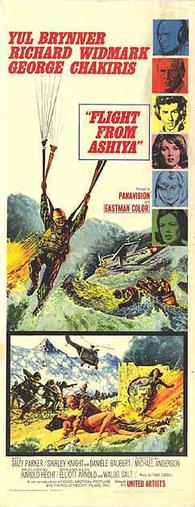Plot
MSgt Mike Takashima (Yul Brynner), Col Glenn Stevenson (Richard Widmark) and 1st Lt John Gregg (George Chakiris), all members of the U. S. Air Force Air Rescue Service at Ashiya Air Base, Japan, set out to rescue the survivors of a Japanese ship wrecked in a still-raging storm. As they fly to the site of the wreck, each man recalls a part of his past: Gregg remembers the avalanche caused in Europe when his Sikorsky H-19 Chickasaw helicopter came too close to a mountain. The avalanche subsequently buried alive the group of people whom he was attempting to rescue.
The accident has since caused him to fear flying solo. Stevenson, deeply prejudiced against the Japanese, recalls the reason for his hatred: as a civilian pilot in the Philippines prior to World War II, he met and married Caroline Gordon (Shirley Knight). She and their infant son later died in a Japanese prison camp when they were refused medical supplies which were being saved for Japanese soldiers. Takashima, half-Polish (mother), half-Japanese (father), reminisces about his tragic love affair with Leila (Danièle Gaubert), an Algerian girl, when he was an Army paratrooper during World War II. He was unable to stop a bridge from being blown up, a bridge where Leila had run to look for him after learning that his unit was being withdrawn from town.
Stevenson, Gregg and Takashima are the crew of the lead aircraft of a flight of two Grumman HU-16 Albatross seaplanes dispatched to rescue the Japanese civilians at sea. When one HU-16 crashes in the rough seas, Stevenson refuses to jeopardize his aircraft for Japanese lives. At the last minute, however, he recalls Caroline's dying plea not to hate; he overcomes his prejudice.
Takashima volunteered to parachute to the life rafts with rescue equipment. Stevenson and Gregg then land the aircraft at sea and rescue the survivors, but when Stevenson is injured in the landing, Gregg is forced to overcome his fear and handle the dangerous takeoff and the flight back to Ashiya.
Reception
Film reviewer Howard Thompson in writing in The New York Times , was scathing in his review of Flight From Ashiya: "Occasionally, it's diverting to see just how consistently bad a picture can be. Anyone interested should catch 'Flight From Ashiya', which opened yesterday at the Palace and other Premiere Showcase theaters." [8]
Aviation film historian Stephen Pendo, in Aviation in the Cinema (1985) had a similar reaction; Flight from Ashiya was "dull" and ruined by "too many flashbacks." [9]
This page is based on this
Wikipedia article Text is available under the
CC BY-SA 4.0 license; additional terms may apply.
Images, videos and audio are available under their respective licenses.
